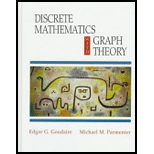
Discrete Mathematics with Graph Theory (Classic Version) (3rd Edition) (Pearson Modern Classics for Advanced Mathematics Series)
3rd Edition
ISBN: 9780134689555
Author: Edgar Goodaire, Michael Parmenter
Publisher: PEARSON
expand_more
expand_more
format_list_bulleted
Textbook Question
Chapter 5.1, Problem 21E
Prove the Chinese Remainder Theorem, 4.5.1, by mathematical induction.
Expert Solution & Answer
Want to see the full answer?
Check out a sample textbook solution
Chapter 5 Solutions
Discrete Mathematics with Graph Theory (Classic Version) (3rd Edition) (Pearson Modern Classics for Advanced Mathematics Series)
Ch. 5.1 - True/False Questions The statement i=1n(2i1)=n2...Ch. 5.1 - Prob. 2TFQCh. 5.1 - Prob. 3TFQCh. 5.1 - Prob. 4TFQCh. 5.1 - Prob. 5TFQCh. 5.1 - Prob. 6TFQCh. 5.1 - Prob. 7TFQCh. 5.1 - Prob. 8TFQCh. 5.1 - Prob. 9TFQCh. 5.1 - Prob. 10TFQ
Ch. 5.1 - Prob. 1ECh. 5.1 - Prob. 2ECh. 5.1 - Prove that it is possible to fill an order for n32...Ch. 5.1 - Use mathematical induction to prove the truth of...Ch. 5.1 - Prove by mathematical induction that...Ch. 5.1 - Use mathematical induction to establish the truth...Ch. 5.1 - 7. Rewrite each of the sums in Exercise 6 using...Ch. 5.1 - 8. Use mathematical induction to establish each of...Ch. 5.1 - 9. Use mathematical induction to establish the...Ch. 5.1 - Prob. 10ECh. 5.1 - Prob. 11ECh. 5.1 - Prob. 12ECh. 5.1 - Prob. 13ECh. 5.1 - Prob. 14ECh. 5.1 - Prob. 15ECh. 5.1 - Prob. 16ECh. 5.1 - Prob. 17ECh. 5.1 - Prob. 18ECh. 5.1 - Prob. 19ECh. 5.1 - Prob. 20ECh. 5.1 - 21. Prove the Chinese Remainder Theorem, 4.5.1, by...Ch. 5.1 - Prob. 22ECh. 5.1 - Prob. 23ECh. 5.1 - Prob. 24ECh. 5.1 - Prob. 25ECh. 5.1 - Prob. 26ECh. 5.1 - Prob. 27ECh. 5.1 - Prob. 28ECh. 5.1 - Prob. 29ECh. 5.1 - Given an equal arm balance capable of determining...Ch. 5.1 - Prob. 31ECh. 5.1 - 32. Let be any integer greater than 1. Show that...Ch. 5.1 - Prob. 33ECh. 5.1 - Prob. 34ECh. 5.1 - Prob. 35ECh. 5.1 - Prob. 36ECh. 5.1 - Prob. 37ECh. 5.1 - 38. For a given natural number prove that the set...Ch. 5.1 - 39. (a) Prove that the strong form of the...Ch. 5.1 - Prob. 40ECh. 5.1 - Prob. 41ECh. 5.2 - True/False Questions
If and for , then .
Ch. 5.2 - Prob. 2TFQCh. 5.2 - Prob. 3TFQCh. 5.2 - Prob. 4TFQCh. 5.2 - Prob. 5TFQCh. 5.2 - Prob. 6TFQCh. 5.2 - Prob. 7TFQCh. 5.2 - True/False Questions The Fibonacci sequence arose...Ch. 5.2 - Prob. 9TFQCh. 5.2 - Prob. 10TFQCh. 5.2 - Give recursive definitions of each of the...Ch. 5.2 - Find the first seven terms of the sequence {an}...Ch. 5.2 - Let a1,a2,a3,...... be the sequence defined by...Ch. 5.2 - Prob. 4ECh. 5.2 - Prob. 5ECh. 5.2 - Prob. 6ECh. 5.2 - Prob. 7ECh. 5.2 - 8. Suppose is a sequence such that and, for, ....Ch. 5.2 - Prob. 9ECh. 5.2 - Prob. 10ECh. 5.2 - Prob. 11ECh. 5.2 - Prob. 12ECh. 5.2 - Prob. 13ECh. 5.2 - Prob. 14ECh. 5.2 - Prob. 15ECh. 5.2 - Prob. 16ECh. 5.2 - Prob. 17ECh. 5.2 - 18. Consider the arithmetic sequence with first...Ch. 5.2 - Prob. 19ECh. 5.2 - Prob. 20ECh. 5.2 - Prob. 21ECh. 5.2 - Prob. 22ECh. 5.2 - Prob. 23ECh. 5.2 - Prob. 24ECh. 5.2 - Prob. 25ECh. 5.2 - Prob. 26ECh. 5.2 - Prob. 27ECh. 5.2 - Prob. 28ECh. 5.2 - Prob. 29ECh. 5.2 - Prob. 30ECh. 5.2 - Prob. 31ECh. 5.2 - 32. (a) Find the 19th and 100th terms of the...Ch. 5.2 - Given that each sum below is the sum of part of an...Ch. 5.2 - Prob. 34ECh. 5.2 - 35. Is it possible for an arithmetic sequence to...Ch. 5.2 - Prob. 36ECh. 5.2 - Prob. 37ECh. 5.2 - Prob. 38ECh. 5.2 - Prob. 39ECh. 5.2 - Prob. 40ECh. 5.2 - Prob. 41ECh. 5.2 - Prob. 42ECh. 5.2 - Prob. 43ECh. 5.2 - 44. Define a sequence recursively as follows:
...Ch. 5.2 - Prob. 45ECh. 5.2 - Prob. 46ECh. 5.2 - Prob. 47ECh. 5.2 - 48. Represent the Fibonacci sequence by , for...Ch. 5.2 - Prob. 49ECh. 5.2 - Prob. 50ECh. 5.2 - Prob. 51ECh. 5.2 - Prob. 52ECh. 5.2 - Prob. 53ECh. 5.2 - Prob. 54ECh. 5.2 - Prob. 55ECh. 5.2 - Prob. 56ECh. 5.2 - Prob. 57ECh. 5.2 - Prob. 58ECh. 5.3 - True/False Questions
The recurrence relation can...Ch. 5.3 - Prob. 2TFQCh. 5.3 - Prob. 3TFQCh. 5.3 - Prob. 4TFQCh. 5.3 - Prob. 5TFQCh. 5.3 - Prob. 6TFQCh. 5.3 - Prob. 7TFQCh. 5.3 - Prob. 8TFQCh. 5.3 - Prob. 9TFQCh. 5.3 - Prob. 10TFQCh. 5.3 - Solve the recurrence relation, , given .
Ch. 5.3 - Prob. 2ECh. 5.3 - Solve the recurrence relation, , given .
Ch. 5.3 - Solve the recurrence relation an+1=7an10an1, n2,...Ch. 5.3 - Prob. 5ECh. 5.3 - 6. Solve the recurrence relation, , given
Ch. 5.3 - 7. Solve the recurrence relation , , given .
Ch. 5.3 - 8. Solve the recurrence relation , , given ....Ch. 5.3 - 9. Solve the recurrence relation , , given ....Ch. 5.3 - 10. (a) Solve the recurrence relation , , given ....Ch. 5.3 - Prob. 11ECh. 5.3 - Prob. 12ECh. 5.3 - Solve the recurrence relation an=5an16an2, n2,...Ch. 5.3 - Prob. 14ECh. 5.3 - Prob. 15ECh. 5.3 - Solve the recurrence relation an=4an14an2+n, n2,...Ch. 5.3 - Prob. 17ECh. 5.3 - Prob. 18ECh. 5.3 - Prob. 19ECh. 5.3 - Prob. 20ECh. 5.3 - Prob. 21ECh. 5.3 - Prob. 22ECh. 5.3 - 23. The Towers of Hanoi is a popular puzzle. It...Ch. 5.3 - 24. Suppose we modify the traditional rules for...Ch. 5.3 - Prob. 25ECh. 5.3 - Prob. 26ECh. 5.3 - Prob. 27ECh. 5.4 - Prob. 1TFQCh. 5.4 - Prob. 2TFQCh. 5.4 - Prob. 3TFQCh. 5.4 - Prob. 4TFQCh. 5.4 - Prob. 5TFQCh. 5.4 - Prob. 6TFQCh. 5.4 - Prob. 7TFQCh. 5.4 - Prob. 8TFQCh. 5.4 - Prob. 9TFQCh. 5.4 - Prob. 10TFQCh. 5.4 - Prob. 1ECh. 5.4 - Prob. 2ECh. 5.4 - Prob. 3ECh. 5.4 - Prob. 4ECh. 5.4 - Prob. 5ECh. 5.4 - Prob. 6ECh. 5.4 - Prob. 7ECh. 5.4 - Prob. 8ECh. 5.4 - Prob. 9ECh. 5.4 - Prob. 10ECh. 5.4 - Prob. 11ECh. 5.4 - Prob. 12ECh. 5.4 - Prob. 13ECh. 5.4 - Prob. 14ECh. 5 - Use mathematical induction to show that...Ch. 5 - Using mathematical induction, show that
for all...Ch. 5 - Using mathematical induction, show that (112)n1n2...Ch. 5 - Prove that for all integers.
Ch. 5 - 5. Use mathematical induction to prove that is...Ch. 5 - 6. Prove that for all.
Ch. 5 - Prob. 7RECh. 5 - 8. (a) Give an example of a function with domaina...Ch. 5 - Give a recursive definition of each of the...Ch. 5 - Guess a simple formula for each of the following...Ch. 5 - 11. Consider the sequence defined by and for. What...Ch. 5 - 12. Find the sum.
Ch. 5 - 13. Let be defined recursively by and, for , ....Ch. 5 - Define f:ZZ by f(a)=34a, and for tZ define a...Ch. 5 - Consider the arithmetic sequence that begins...Ch. 5 - 16. The first two terms of a sequence are 6 and 2....Ch. 5 - 17. Let be the first four terms of an arithmetic...Ch. 5 - Explain why the sum of 500 terms of the series...Ch. 5 - 19. (a) Define the Fibonacci sequence.
(b) Is it...Ch. 5 - Show that, for n2, the nth term of the Fibonacci...Ch. 5 - Let f1,f2,....... be the Fibonacci sequence as...Ch. 5 - Suppose you walk up a flight of stairs one or two...Ch. 5 - 23. Solve the recurrence relation given that and...Ch. 5 - Solve Exercise 23 using the method of generating...Ch. 5 - 25. Find a formula for, given and for .
Ch. 5 - Let an be the sequence defined by a0=2,a1=1, and...Ch. 5 - Prob. 27RECh. 5 - Prob. 28RECh. 5 - Prob. 29RECh. 5 - 30. (For students of calculus) Let denote the...
Knowledge Booster
Learn more about
Need a deep-dive on the concept behind this application? Look no further. Learn more about this topic, subject and related others by exploring similar questions and additional content below.Similar questions
- Label each of the following statement as either true or false. Let and be integers with. Then if and only if the remainder in the Division Algorithm, when is divided by, isarrow_forwardLet x and y be integers, and let m and n be positive integers. Use mathematical induction to prove the statements in Exercises 1823. ( The definitions of xn and nx are given before Theorem 2.5 in Section 2.1 ) n(x+y)=nx+nyarrow_forwardIn Exercise , use generalized induction to prove the given statement. for all integersarrow_forward
arrow_back_ios
arrow_forward_ios
Recommended textbooks for you
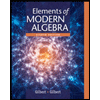 Elements Of Modern AlgebraAlgebraISBN:9781285463230Author:Gilbert, Linda, JimmiePublisher:Cengage Learning,
Elements Of Modern AlgebraAlgebraISBN:9781285463230Author:Gilbert, Linda, JimmiePublisher:Cengage Learning,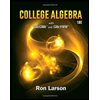 Algebra & Trigonometry with Analytic GeometryAlgebraISBN:9781133382119Author:SwokowskiPublisher:Cengage
Algebra & Trigonometry with Analytic GeometryAlgebraISBN:9781133382119Author:SwokowskiPublisher:Cengage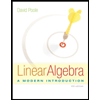 Linear Algebra: A Modern IntroductionAlgebraISBN:9781285463247Author:David PoolePublisher:Cengage Learning
Linear Algebra: A Modern IntroductionAlgebraISBN:9781285463247Author:David PoolePublisher:Cengage Learning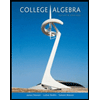 College AlgebraAlgebraISBN:9781305115545Author:James Stewart, Lothar Redlin, Saleem WatsonPublisher:Cengage Learning
College AlgebraAlgebraISBN:9781305115545Author:James Stewart, Lothar Redlin, Saleem WatsonPublisher:Cengage Learning

Elements Of Modern Algebra
Algebra
ISBN:9781285463230
Author:Gilbert, Linda, Jimmie
Publisher:Cengage Learning,


Algebra & Trigonometry with Analytic Geometry
Algebra
ISBN:9781133382119
Author:Swokowski
Publisher:Cengage

Linear Algebra: A Modern Introduction
Algebra
ISBN:9781285463247
Author:David Poole
Publisher:Cengage Learning

College Algebra
Algebra
ISBN:9781305115545
Author:James Stewart, Lothar Redlin, Saleem Watson
Publisher:Cengage Learning
Algebraic Complexity with Less Relations; Author: The University of Chicago;https://www.youtube.com/watch?v=ZOKM1JPz650;License: Standard Youtube License
Strassen's Matrix Multiplication - Divide and Conquer - Analysis of Algorithm; Author: Ekeeda;https://www.youtube.com/watch?v=UnpySHwAJsQ;License: Standard YouTube License, CC-BY
Trigonometric Equations with Complex Numbers | Complex Analysis #6; Author: TheMathCoach;https://www.youtube.com/watch?v=zdD8Dab1T2Y;License: Standard YouTube License, CC-BY